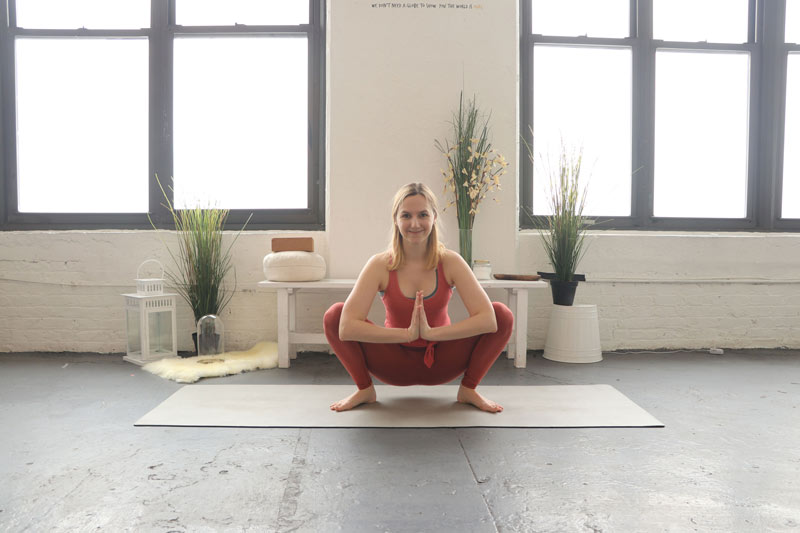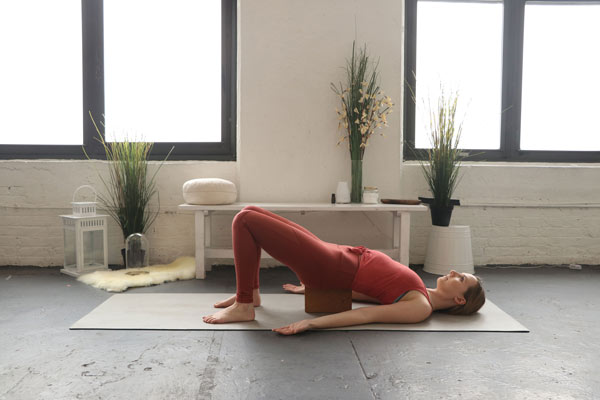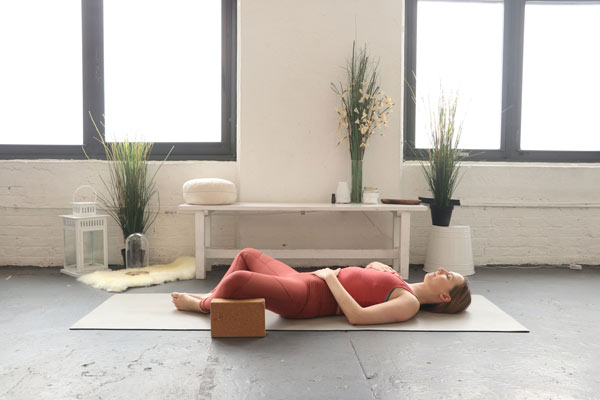 A woman’s body is subject to several changes between puberty and menopause; the female body changes during this timespan help prepare her for a possible pregnancy. Driven by hormonal changes, this series of events is called the menstrual cycle. Based on Ayurvedic knowledge, healthy menstruation lasts a few days and occurs every 28 days. Menstruation usually appears around 12 to 13 in girls and lasts until the age of 48 to 50. Using yoga and Ayurveda specifically for menstruation, we can ease and balance this aspect of a woman’s life.
A woman’s body is subject to several changes between puberty and menopause; the female body changes during this timespan help prepare her for a possible pregnancy. Driven by hormonal changes, this series of events is called the menstrual cycle. Based on Ayurvedic knowledge, healthy menstruation lasts a few days and occurs every 28 days. Menstruation usually appears around 12 to 13 in girls and lasts until the age of 48 to 50. Using yoga and Ayurveda specifically for menstruation, we can ease and balance this aspect of a woman’s life.
The Female Cycle
The menstrual cycle is related to the waves of the lunar cycle. This cycle usually coincides with an ovulating woman’s menstrual cycle, at an average of 29.5 days. During each menstrual cycle, a developed egg is released from the ovaries. In addition, the uterine lining that builds up during the menstrual cycle sheds in case a pregnancy does not happen.
Menstrual Phases
The menstrual cycle of a woman is divided into four different phases. They are as follows:
-
Menstrual Phase
This is the first stage, which starts when the egg from the previous cycle is not fertilized. This phase is also called a “period.” The levels of the hormones estrogen and progesterone decrease since pregnancy has not taken place. As the uterine lining that supports pregnancy is not needed, the female body releases it. The menstrual flow is the byproduct of the most basic tissues of the body. On average, a woman is in this phase from 3 to 7 days. During the menstrual phase, some of the symptoms can include low back pain, mood swings, bloating, cramps, tiredness, irritability, and headaches.
-
Follicular Phase
This phase overlaps with a woman’s menstrual phase and begins on the first day of their period. It ends when the female body starts ovulating. The phase begins when the pituitary gland sends a signal to the hypothalamus. This signal marks the beginning of the release of follicle-stimulating hormone or FSH. FSH stimulates the ovaries to produce 5 to 20 follicles, each containing an immature egg. Only the healthiest egg matures and is released for potential fertilization. In rare cases, however, 2 or more eggs are released, resulting in fraternal twins, triplets, etc. The rest of the unreleased follicles are reabsorbed by the body. This follicle, rich in estrogen, thickens the uterine lining and creates an environment rich in nutrients. It is the perfect environment for the embryo to grow. This phase’s average time is 16 days but varies between 11 and 27 days, depending on a woman’s menstrual cycle. Read more about yoga for fertility.
-
Ovulation Phase
The pituitary gland releases luteinizing hormone, or LH, due to estrogen levels rising during the follicular phase; this begins the process of ovulation. During ovulation, the woman’s body releases a mature egg that travels down the fallopian tube to the uterus. This is the only phase during the menstrual cycle that creates the potential to get pregnant. Some of the ovulating symptoms include a rise in basal body temperature and a thicker, egg-like discharge. Ovulation occurs right in the middle of the 28-day menstrual cycle, typically around the 14th day. It only lasts for 24 hours, after which, if the egg is not fertilized, the cycle continues to the luteal phase.
-
Luteal Phase
When the follicle releases the egg, it changes into the corpus luteum, which causes the release of the hormones estrogen and progesterone. If a woman gets pregnant, the body will release chorionic gonadotropin (hCG), which helps maintain the corpus luteum. The body reabsorbs this structure if the woman does not get pregnant. Furthermore, it decreases the level of hormones and causes menstruation to begin. The average length of this phase is 14 days, and some of its symptoms include food cravings, weight gain, trouble sleeping, changes in sexual desire, and swelling of breasts.
Ayurvedic Doshas In Menstruation
Ayurveda for menstruation has a unique way of examining the menstrual cycle as a window into the female body. The three Ayurvedic doshas, Vata, Pitta, and Kapha, determine nature’s forces within and without the body, including during menstruation. Recognizing which dosha affects your menstrual most will help to manage bodily imbalances.
-
Vata-Vitiated Menstruation
While the Vata dosha percolates its way into the uterus through the blood vessels, the rough, dry, and cold qualities accompany a sense of tightening. Blood vessels constrict, and dryness depletes all the tissues, which can lead to emaciation. The process is facilitated by a decrease in plasma and nourishment of the uterine lining. This decreases the overall discharge. Most Vata-centric cycles bring discomfort during menstruation. Imbalances include prickling and sharp discomfort in the lower abdominal or back region. During the Vata-centric menstrual phase, there is a rise in anxiety, fear, and nervousness. The flow becomes frothy, dry, light, and dark in color. Stiffness is a potential imbalance during this phase.
To balance Vata-vitiated menstruation, get plenty of rest, eat well-cooked food, practice slow and gentle yoga and give yourself a warm oil massage.
-
Pitta-Vitiated Menstruation
The characteristics of Pitta are hot and sharp. It enables the blood to flow freely due to its warm, fluid, and spreading nature. Pitta-centric menstrual cycles are usually heavy because the dosha resides in excess in the blood. The warm nature of Pitta can cause swelling and irritation to the body. Women who are Pitta-centric may experience a burning sensation during their period. It induces a feeling of irritability and anger. The signs of menstruation include hot, profuse, yellow or red-colored, foul-smelling, heavy flow. Some of the notable imbalances in the Pitta-vitiated menstrual flow are increased bodily temperature, acne, diarrhea, nausea, and excess swelling of the body.
To balance Pitta, eat cooling food (like cucumbers, coconut, cilantro), avoid spicy food and stay cool (e.g. get a cool foot bath).
-
Kapha-Vitiated Menstruation
Women with Kapha imbalance go through stagnation, dullness, heaviness, coolness, and stickiness. Obstruction and blockages increase with stagnation. The plasma is a comfortable home for the Kapha dosha. Swelling and bloating increase in Kapha-centric women during their menstrual period. The intensity of the blockage can result in an overgrowth of tissues. Women who have a Kapha imbalance experience a heavier flow than the Vata cycle. Depression and emotional instability are persistent feelings. Heavier, longer, and yellowish flow is apparent. Increased sleeping, leucorrhea, swelling, and bloating are common issues.
To balance Kapha, stay warm, practice free-flowing light yoga and eat easy-to-digest and light food.
Yoga Poses For Menstruation
Balancing the dosha during the menstrual cycle means you need to treat imbalances with opposite qualities. For example, a woman with a Vata-centric menstrual cycle (rough, dry, cold) should draw qualities of warmth, oiliness, and heaviness. Yoga helps ease the body and facilitates a healthier, more comfortable menstruation cycle. It is essential to recognize the dominant dosha in your body to follow appropriate yoga techniques during different phases of your menstrual cycle.
Here are some of the important tips to balance the different doshas during menstruation:
-
Garland Pose
Restorative and hip-opening poses are beneficial during the menstrual phase. This is a squatting asana for balancing the menstrual phase. This pose helps increase the body’s metabolism, promotes the digestive system’s activation, tones the belly, and strengthens the groin. All these factors are essential for maintaining a healthy reproductive system.
-
 Heating Yoga Poses
Heating Yoga Poses
There is a considerable rise in testosterone levels during the follicular phase. This is an ideal time to try new and more energetic yoga techniques. It challenges your physical limitations and enables you to achieve further balance. Practicing the heating yoga poses (like chair, plank, Sun Salutations, boat, etc.) during this time is highly beneficial for women. It helps them burn more calories, reduce blood glucose levels, build bone density, improve flexibility, and nourish the skin.
This is a highly beneficial pose for women in the ovulating phase. The bridge pose helps relieve anxiety and stress. It stimulates the abdominal organs, rejuvenates tired legs, and relieves you of menstrual discomfort. A heart-opening full moon yoga practice complements the ovulating phase beautifully.
-
 Reclined Bound Angle Pose
Reclined Bound Angle Pose
A woman in her luteal phase of menstruation can consider this yoga pose. This yoga pose helps stretch the inner thighs, knees, and groin. The reclined bound angle pose is an energy-based practice that stimulates the ovaries, prostate gland, kidneys, and bladder. This pose helps to relieve the symptoms of menstruation.
 The Takeaway
The Takeaway
While menstruation is common in women, they experience different cycles depending on their bodily constitution. Ayurveda and Yoga for menstruation promote a harmonious lifestyle and are a great way to restore the body’s natural rhythms. Understanding your dominant dosha and practicing an appropriate yoga pose for the different menstrual phases is essential for women to maintain their balance and health during menstruation.

